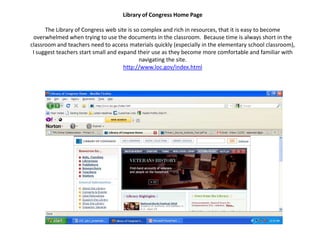Neme july1 tps_mentoringpresentation.docx
- 1. Library of Congress Home PageThe Library of Congress web site is so complex and rich in resources, that it is easy to become overwhelmed when trying to use the documents in the classroom. Because time is always short in the classroom and teachers need to access materials quickly (especially in the elementary school classroom), I suggest teachers start small and expand their use as they become more comfortable and familiar with navigating the site. http://www.loc.gov/index.html
- 2. Primary Sources Student Investigations Sheethttp://www.loc.gov/teachers/usingprimarysources/resources/Primary_Source_Analysis_Tool.pdfHaving a guide for student use is invaluable in helping students to observe, reflect, and develop questions about what else the student would like to know about the primary resource. I would make sure the teachers I would mentor would download this sheet and keep the URL bookmarked on a primary sources bookmark list.
- 3. Teacher Guide Analyzing Primary Sourceshttp://www.loc.gov/teachers/usingprimarysources/resources/Analyzing_Primary_Sources.pdf
- 4. The Teacher PageWhile it is tempting to explore the enticing links on the home page (and the Ī░Popular CollectionsĪ▒ section beckons teachers of American history) a solid place to start is to click on the left hand side of the home page at the top called Ī░Resources for:Ī▒ and I would direct my group to click on Ī░TeachersĪ▒.
- 5. Primary Source Sets A methodical approach would be to choose Ī░Classroom MaterialsĪ▒ and click on the Ī░All Primary Source SetsĪ▒ below the Jim Crow graphic and description. The sets available span time and offer a range of topics using the primary sources. I would suggest that the teachers choose one appropriate to curriculum/class needs and stay within the set to facilitate students digging deeper with observations, reflections and questions they develop. By remaining within one set one can concentrate on the exercise of analyzing and interpreting the primary sources. For elementary school students a smaller scope of choices offers a manageable responsibility which can always be expanded given the numerous options.
- 6. The Teacher Guide for each topic in .pdf format is a powerful support for the teacher who may need the additional information in order to guide student investigations. I would suggest downloading the Teacher Guide of each and every set on that Ī░All Primary Source SetsĪ▒ page along with the .pdf of the images. Teachers on the same grade can work collaboratively each working with one or two primary source sets and switching classes to work with students on the prepared set. This offers an expedient use of limited time while still accomplishing the goal of examining several primary source sets thematically organized.http://www.loc.gov/teachers/classroommaterials/primarysourcesets/thanksgiving/
- 7. With the NYS grades 5 and 8 Social Studies Exams eliminated we have an opportunity to hit the ground running and begin work with Primary Sources in earnest (minus the test prep!!). The next step would be to have students write a 2 minute (maximum) script of their findings for a podcast. Many teachers are familiar with podcasting and for those who are not, this might be the opportunity to let students shine. I have 5 iPod touch devices in the class and the students showed me many things they can do with it to record, read, listen to books online (ICDL), and conduct searches of the Library of Congress web site.
- 8. This is a very small segment with which to begin mentoring a small group of teachers, but by starting small, I am convinced that the teachers can navigate these links with ease. Simplicity of use will hopefully encourage ongoing use so that students appreciate what those resources can contribute to their understanding and deeper questions
- 9. Neme AlpersteinJuly 1, 2010









